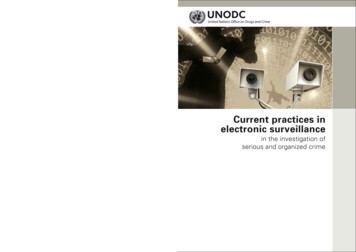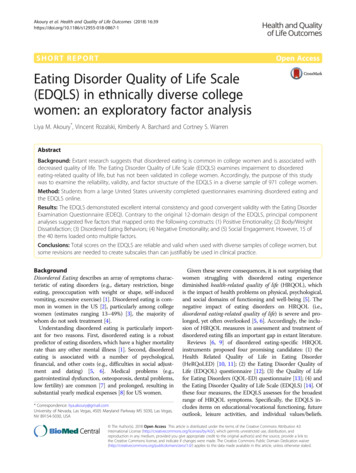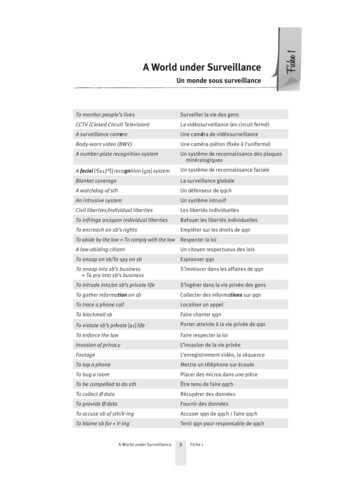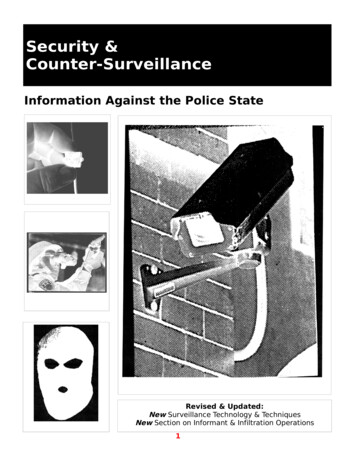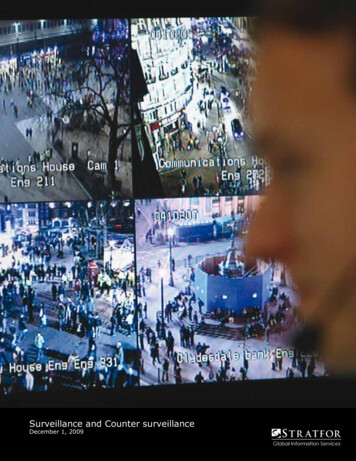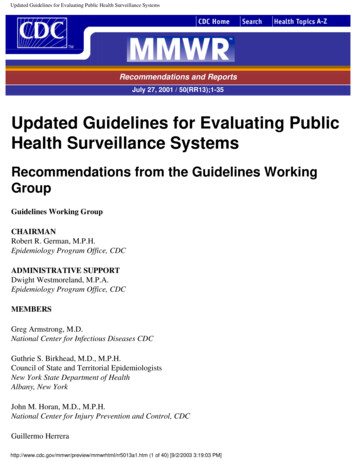
Transcription
1Behavioral Risk Factor Surveillance SystemOVERVIEW: BRFSS 2020July 7, 2021
2BackgroundThe Behavioral Risk Factor Surveillance System (BRFSS) is a collaborative project between all of the states inthe United States and participating US territories and the Centers for Disease Control and Prevention (CDC).The BRFSS is administered and supported by CDC's Population Health Surveillance Branch, under the Divisionof Population Health at CDC’s National Center for Chronic Disease Prevention and Health Promotion. TheBRFSS is a system of ongoing health-related telephone surveys designed to collect data on health-related riskbehaviors, chronic health conditions, and use of preventive services from the noninstitutionalized adultpopulation ( 18 years) residing in the United States.The BRFSS was initiated in 1984, with 15 states collecting surveillance data on risk behaviors through monthlytelephone interviews. Over time, the number of states participating in the survey increased; BRFSS now collectsdata in all 50 states as well as the District of Columbia and participating US territories. During 2020, all 50states, the District of Columbia, Guam, and Puerto Rico collected BRFSS data. In this document, the term“state” is used to refer to all areas participating in the BRFSS, including the District of Columbia, Guam, andthe Commonwealth of Puerto Rico.BRFSS’s objective is to collect uniform state-specific data on health risk behaviors, chronic diseases andconditions, access to health care, and use of preventive health services related to the leading causes ofdeath and disability in the United States. Factors assessed by the BRFSS in 2020 included health status andhealthy days, exercise, inadequate sleep, chronic health conditions, oral health, tobacco use, cancer screenings,and health-care access (core section). Optional Module topics for 2020 included prediabetes and diabetes,cognitive decline, electronic cigarettes, cancer survivorship (type, treatment, pain management) and sexualorientation/gender identity (SOGI). Refer to the 2020 BRFSS Questionnaire for the full list of topics andofferings.Since 2011, the BRFSS has been conducting both landline telephone- and cellular telephone-based surveys. Allthe responses were self-reported; proxy interviews are not conducted by the BRFSS. In conducting the landlinetelephone survey, interviewers collect data from a randomly selected adult in a household. In conducting thecellular telephone survey, interviewers collect data from adults answering the cellular telephones residing in aprivate residence or college housing. Beginning in 2014, all adults contacted through their cellular telephonewere eligible, regardless of their landline phone use (i.e., complete overlap).
3The BRFSS field operations are managed by state health departments that follow protocols adopted by thestates, with technical assistance provided by CDC. State health departments collaborate during surveydevelopment and conduct the interviews themselves or use contractors. The data are transmitted to CDC forediting, processing, weighting, and analysis. An edited and weighted data file is provided to each participatingstate health department for each year of data collection, and summary reports of state-specific data are preparedby CDC. State health departments use the BRFSS data for a variety of purposes, including identifyingdemographic variations in health-related behaviors; designing, implementing, and evaluating public healthprograms; addressing emergent and critical health issues; proposing legislation for health initiatives; andmeasuring progress toward state health objectives.1 For specific examples of how state officials use the finalizedBRFSS data sets, please refer to the appropriate state information on the BRFSS website.Health characteristics estimated from the BRFSS pertain to the noninstitutionalized adult population—aged 18years or older—who reside in the United States. In 2020, an optional module was included to provide a measurefor several childhood health and wellness indicators, including asthma prevalence for people aged 17 years oryounger. BRFSS respondents are identified through telephone-based methods. According to the 2019 AmericanCommunity Survey (ACS), 99% of all occupied housing units in the United States had telephone serviceavailable and telephone non-coverage ranged from less than 1.0% in several states to 1.6% in South Dakota.2 Itis estimated that 3.5% of occupied households in Puerto Rico did not have telephone service.2 The increasingpercentage of households that are abandoning their landline telephones for cellular telephones has significantlyeroded the population coverage provided by landline telephone-based surveys to pre-1970s levels. Thepreliminary results (January to June 2020) from the National Health Interview Survey (NHIS) indicate that61.8% of adults were wireless-only.3 Using a dual-frame survey including landline and cellular telephonesimproved the validity, data quality, and representativeness of BRFSS data.In 2011, a new weighting methodology called iterative proportional fitting (or “raking”)4 replaced the poststratification method to weight BRFSS data. Raking allows incorporation of cellular telephone survey data andpermits the introduction of additional demographic characteristics (e.g., education level, marital status, homerenter/owner) in addition to age-race/ethnicity-gender that improve the degree and extent to which the BRFSSsample properly reflects the sociodemographic make-up of individual states. The 2020 BRFSS raking methodincludes categories of age by gender, detailed race and ethnicity groups, education levels, marital status, regionswithin states, gender by race and ethnicity, telephone source, renter or owner status, and age groups by race andethnicity. In 2020, 50 states, the District of Columbia, Guam, and Puerto Rico collected samples of interviewsconducted by landline and cellular telephone.
The BRFSS DesignThe BRFSS QuestionnaireEach year, the states—represented by their BRFSS coordinators and CDC—agree on the content of thequestionnaire. The BRFSS questionnaire consists of a core component, optional modules, and state-addedquestions. Many questions are taken from established national surveys, such as the National Health InterviewSurvey or the National Health and Nutrition Examination Survey. This practice allows the BRFSS to takeadvantage of questions that have been tested and allows states to compare their data with those from othersurveys. Any new questions that states, federal agencies, or other entities propose as additions to the BRFSSmust go through cognitive testing and field testing before they can become part of the BRFSS questionnaire. Inaddition, a majority vote of all state representatives is required before questions are adopted. The BRFSSguidelines—agreed upon by the state representatives and CDC—specify that all states ask the core componentquestions without modification. They may choose to add any, all, or none of the optional modules and may addquestions of their choosing as state-added questions.The questionnaire has three parts:1. Core component: A standard set of questions that all states use. Core content includes queries about currenthealth-related perceptions, conditions, and behaviors (e.g., health status, health-care access, alcoholconsumption, tobacco use, consumption of fruits and vegetables, HIV/AIDS risks), as well as demographicquestions. The core component includes the annual core comprising questions asked each year and rotating corequestions that are included in even- and odd–numbered years.2. Optional BRFSS modules: These are sets of questions on specific topics (e.g., prediabetes, diabetes, sugarsweetened beverages, excess sun exposure, caregiving, shingles, cancer survivorship) that states elect to use ontheir questionnaires. Generally, CDC programs submit module questions and the states vote to adopt finalquestions that can be included as optional modules. For more information, please see the questionnaire sectionof the BRFSS website.3. State-added questions: Individual states develop or acquire these questions and add them to their BRFSSquestionnaires. CDC does not edit, evaluate, track or report responses from these questions.The BRFSS supported 23 modules in 2020, but states limited their use of modules and state-added questions toonly the most helpful to their state program purposes, in order to keep surveys at a reasonable length. Becausedifferent states have different needs, there is wide variation between states in terms of question totals each year.The BRFSS implements a new questionnaire in January and usually does not change it significantly for the rest
5of the year. The flexibility of state-added questions, however, does permit additions, changes, and deletions atany time during the year.The 2020 list of optional modules used on both the landline telephone and cellular telephone surveys isavailable on the BRFSS website. In order to allow for a wider range of questions in optional modules, combinedlandline telephone and cellular telephone data for 2020 include up to three split versions of the questionnaire. Asplit version is used when a subset of telephone numbers for data collection still followed the state sampledesign, and administrators used it as the state’s BRFSS sample, but the optional modules and state-addedquestions may have been different from other split-version questionnaires. For additional information on splitversion questionnaires, see the 2020 module data appendix table, published with this yearly release.Annual Questionnaire DevelopmentThe governance of the BRFSS includes a representative body of state health officials, elected by region. Duringthe year, the State BRFSS Coordinators Working Group meets with CDC’s BRFSS program management.Before the beginning of the calendar year, CDC provides states with the text of the core component and theoptional modules that the BRFSS will support in the coming year. States select their optional modules and readyany state-added questions they plan to use. Each state then constructs its own questionnaire. The order of thequestioning is always the same—interviewers ask questions from the core component first, then they ask anyquestions from the optional modules, and the state-added questions. This content order ensures comparabilityacross states and follows the BRFSS guidelines. Generally, the only changes that the standard protocol allowsare limited insertions of state-added questions on topics related to core questions. CDC and state partners mustagree to these exceptions. In some cases, however, states have not been able to follow all set guidelines. Usersshould refer to the yearly Comparability of Data document, which lists the known deviations.Once each state finalizes its questionnaire content—consisting of the core questionnaire, optional modules, andstate-added questions—the state prepares a hard copy or electronic version of the instrument and sends it toCDC. States use the questionnaire without changes for one calendar year, and CDC archives a copy on theBRFSS website. If a significant portion of any state’s population does not speak English, states have the optionof translating the questionnaire into other languages. Currently, CDC provides a Spanish version of the corequestionnaire and optional modules. Specific wording of the Spanish version of the questionnaire may beadapted by the states to fit the needs of their Hispanic populations.
6Sample DescriptionIn a telephone survey such as the BRFSS, a sample record is one telephone number in the list of all telephonenumbers the system randomly selects for dialing. To meet the BRFSS standard for the participating states'sample designs, one must be able to justify sample records as a probability sample of all households withtelephones in the state. All participating areas met this criterion in 2020. Fifty-one projects used adisproportionate stratified sample (DSS) design for their landline samples. Guam and Puerto Rico used a simplerandom-sample design.In the type of DSS design that states most commonly used in the BRFSS landline telephone sampling, theBRFSS divides telephone numbers into two groups, or strata, which are sampled separately. The high-densityand medium-density strata contain telephone numbers that are expected to belong mostly to households.Whether a telephone number goes into the high-density or medium-density stratum is determined by the numberof listed household numbers in its hundred block, or set of 100 telephone numbers with the same area code,prefix, and first 2 digits of the suffix and all possible combinations of the last 2 digits. BRFSS puts numbersfrom hundred blocks with 1 or more listed household numbers (1 blocks, or banks) in either the high-densitystratum (listed 1 blocks) or medium-density stratum (unlisted 1 blocks). The BRFSS samples the two stratato obtain a probability sample of all households with telephones.Cellular telephone sampling frames are commercially available, and the system can call random samples ofcellular telephone numbers, but doing so requires specific protocols. The basis of the 2020 BRFSS samplingframe is the Telecordia database of telephone exchanges (e.g., 617-492-0000 to 617-492-9999) and 1,000 banks(e.g., 617-492-0000 to 617-492-0999). The vendor uses dedicated cellular 1,000 banks, sorted on the basis ofarea code and exchange within a state. The BRFSS forms an interval—K—by dividing the population count oftelephone numbers in the frame—N—by the desired sample size— n. The BRFSS divides the frame oftelephone numbers into n intervals of size K telephone numbers. From each interval, the BRFSS draws one 10digit telephone number at random.The target population (aged 18 years and older) for cellular telephone samples in 2020 consists of peopleresiding in a private residence or college housing who have a working cellular telephone.In the sample design, states begin with a single stratum. To provide adequate sample sizes for smallergeographically defined populations of interest, however, many states sample disproportionately from strata thatcorrespond to sub-state regions. In 2020, the 47 states with geographic stratification were Alabama, Alaska,Arizona, Arkansas, California, Colorado, Connecticut, Delaware, Florida, Georgia, Hawaii, Idaho, Illinois,Indiana, Iowa, Kansas, Kentucky, Louisiana, Maine, Maryland, Massachusetts, Michigan, Minnesota,Mississippi, Missouri, Montana, Nebraska, Nevada, New Hampshire, New Mexico, New York, North Carolina,
7North Dakota, Ohio, Oklahoma, Pennsylvania, Puerto Rico, Rhode Island, South Carolina, South Dakota,Tennessee, Texas, Utah, Vermont, Virginia, Washington, and Wisconsin. As a precaution to protect theconfidential responses provided by the respondent, specific variables (such as sub-state geographic identifiers,detailed race or ethnicity, and older than 80 years of age) in a given year are removed.State health departments may directly collect data from their states or they may use a contractor. In 2020, sevenstate health departments collected their data in-house and the remainder contracted with other data collectors. In2020, the CDC provided samples purchased from Marketing Systems Group, Inc. (MSG) to all 53 states andterritories.Data CollectionInterviewing ProceduresIn 2020, 53 states or territories used Computer-Assisted Telephone Interview (CATI) systems. CDC supportsCATI programming using the Ci3 WinCATI software package. This support includes programming the coreand module questions for data collectors, providing questionnaire scripting of state-added questions for statesrequiring such assistance, and contracting with a Ci3 consultant to assist states. Following guidelines providedby the BRFSS, state health personnel or contractors conduct interviews. The core portion of the questionnairelasts an average of 17 minutes. Interview time for modules and state-added questions is dependent upon thenumber of questions used, but generally, they add 5 to 10 minutes to the interview.Interviewer retention is very high among states that conduct the survey in-house. The state coordinator orinterviewer supervisor conducts repeated training specific to the BRFSS. Contractors typically use interviewerswho have experience conducting telephone surveys, but these interviewers are given additional training on theBRFSS questionnaire and procedures before they are approved to work on the BRFSS.The BRFSS protocols require evaluation of interviewer performance. During 2020, all BRFSS surveillance siteshad the capability to monitor their interviewers. Interviewer-monitoring systems vary from listening to theinterviewer only at an on-site location to listening to both the interviewer and respondent at remote locations.Some states also use verification callbacks in addition to direct monitoring. Contractors typically conductedsystematic monitoring of each interviewer a certain amount of time each month. All states had the capability totabulate disposition code frequencies by interviewer. These data were the primary means for quantifyinginterviewer performance.States conducted telephone interviews during each calendar month. They made calls 7 days per week, duringboth daytime and evening hours. They followed standard BRFSS procedures for rotation of calls over days of
8the week and time of day. Detailed information on interview response rates is available in the BRFSS 2020Summary Data Quality Report.Data ProcessingPreparing for Data Collection and Data ProcessingData processing is an integral part of any survey. Because states collect and submit data to CDC each month,the BRFSS performs routine data processing tasks on an ongoing basis. Once the final version of the newquestionnaire becomes available each year, CDC staff take steps to prepare for the next cycles of datacollection. These steps include developing edit specifications, programming portions of the Ci3 WinCATIsoftware, programming the editing software, and producing telephone sample estimates as requested by statesand ordering the sample from the contract vendor. CDC produces a Ci3 WinCATI data entry module for eachstate that requests it. CDC staff also must incorporate skip patterns, together with some consistency edits, andresponse-code range checks into the CATI system. These edits and skip patterns serve to reduce interviewer-,data-entry, and skip errors. Developers prepare data conversion tables that help processors read the survey datafrom the entry module, call information from the sample tracking module, and combine information into thefinal format for that data year. CDC also creates and distributes a Windows-based editing program that canperform data validations on files with proper survey result formats. This program helps users with output lists oferrors or warns users about conditions of concern that may exist in the data.CDC begins to process data for the survey year as soon as states (or their contractors) begin submitting data tothe data management mailbox. Data processing continues throughout the survey year. CDC receives and tracksmonthly data submissions from the states. Once data are received from a state, CDC staff run editing programsand cumulative data quality checks and note any problems in the files. A CDC programmer works with eachstate until any problems are optimally resolved. CDC staff generate data quality reports and share them withstate coordinators, who review the reports and discuss any potential problems. Once CDC receives and validatesthe entire year of data for a state, processors run several year-end programs on the data. These programsperform some additional, limited data cleanup and fixes specific to each state and data year and produce reportsthat identify potential analytic problems with the data set. Once this step is completed, data are ready forassigning weights and adding calculated variables. Calculated variables are created for the benefit of users andcan be noted in the data set by the leading underscore in the variable name. The following calculated variablesare examples of results from this procedure: RFSMOK3TOTINDA
9 HCVU651AGE80FLUSHOT7For more information, see the Calculated Variables and Risk Factors in Data Files document. Severalvariables from the data file are used to create these variables in a process that varies in complexity. Some arebased only on combined codes, while others require sorting and combining of particular codes from multiplevariables.Almost every variable derived from the BRFSS interview has a code category labeled refused and assignedvalues of 9, 99, or 999. These values may also be used to represent missing responses. Missing responses maybe due to non-interviews (A non-interview response results when an interview ends prior to this question and aninterviewer codes the remaining responses as refused.) and missing responses due to skip patterns in thequestionnaire. This code, however, may capture some questions that were supposed to have answers, but forsome reason do not have them, and appeared as a blank or another symbol. Combining these types of responsesinto a single code requires vigilance on the part of data file users who wish to separate (1) results of respondentswho did not receive a particular question and (2) results from respondents who, after receiving the question,gave an unclear answer or refused to answer it.Weighting the DataThe BRFSS is designed to obtain sample information on the population of interest i.e., the adult US populationresiding in different states. Data weighting helps make sample data more representative of the population fromwhich the data were collected. BRFSS data weights incorporate the design of BRFSS survey and characteristicsof the population. BRFSS weighting methodology comprises 1) design factors or design weight, and 2) someform of demographic adjustment of the population—by iterative proportional fitting or raking.The design weight accounts for the probability of selection and adjusts for nonresponse bias and non-coverageerrors. Design weights are calculated using the weight of each geographic stratum ( STRWT), the number ofphones within a household (NUMPHON3), and the number of adults aged 18 years and older in therespondent’s household (NUMADULT). For cellphone respondents, both NUMPHON3 and NUMADULT areset to 1. The formula for the design weight isDesign Weight STRWT * (1/NUMPHON3) * NUMADULT
10The stratum weight ( STRWT) accounts for differences in the probability of selection among strata (subsets ofarea code or prefix combinations). It is the inverse of the sampling fraction of each stratum. There is rarely acomplete correspondence between strata (which are defined by subsets of area code or prefix combinations) andregions—which are defined by the boundaries of government entities.BRFSS calculates the stratum weight ( STRWT) using the following items: Number of available records (NRECSTR) and the number of records users select (NRECSEL)within each geographic strata and density strata.Geographic strata (GEOSTR), which may be the entire state or a geographic subset (e.g.,counties, census tracts).Density strata ( DENSTR) indicating the density of the phone numbers for a given block ofnumbers as listed or not listed.Within each GEOSTR* DENSTR combination, BRFSS calculates the stratum weight ( STRWT) from theaverage of the NRECSTR and the sum of all sample records used to produce the NRECSEL. The stratum weightis equal to NRECSTR/NRECSEL.The complete overlapping sample frames required an adjustment to address the respondent’s probability ofselection in both the landline and cell phone sample frame. A compositing factor was calculated for dual usersin landline and cell phone sample frames. The design weight is adjusted by the compositing factor for therecords in the overlapping sample frames and later truncated within geographic region using the meanplus/minus 1.96 times the standard deviation to calculate the truncation limits. The adjusted and truncateddesign weight was used as the raking input weight.BRFSS uses iterative proportional fitting, or raking, to adjust for demographic differences between thosepersons who are sampled and the population that they represent. After combining landline and cellular telephonedata, BRFSS performs raking by adjusting one or a combination of demographic categories at a time in aniterative process until a convergence of a set value is reached. The BRFSS rakes the design weight to 8 margins(gender by age group, race or ethnicity, education, marital status, tenure, gender by race or ethnicity, age group byrace or ethnicity, and phone ownership). If the state had geographic regions, it includes 4 additional margins(region, region by age group, region by gender, and region by race or ethnicity). If the state had at least 1 countywith 500 or more respondents, the BRFSS includes 4 additional margins (county, county by age group, county bygender, and county by race or ethnicity). BRFSS, therefore, uses the adjusted and truncated design weight forraking and produces LLCPWT—the final weight assigned to each respondent.
11The population estimates obtained for building the target totals for raking are from similar sources used inprevious years. Intercensal population estimates were purchased from Claritas, LLC at the county-level for age,race or ethnicity, and gender. These population estimates are used as the population totals for a state across allmargins. The 5-year American Community Survey PUMS data set (2015–2019) was used to obtain estimatesfor margins 3, 4, and 5 (education, marital status, tenure). The noninstitutionalized adults were weighted by theperson-level weights to generate the population estimates. The percentages were then used in the rakingmargins. The telephone ownership estimates for margin 8 were taken from the state wireless estimatepercentages produced by the National Center for Health Statistics (NCHS) and released in December of 2019.Calculation of a Child WeightThe BRFSS calculates the design weight for child weighting from the stratum weight times the inverse of thenumber of telephones in the household and then multiplies by the number of children:Child Design Weight STRWT * (1/NUMPHON3) * CHILDRENCHIILDWT BRFSS rakes the child design weight to 5 margins including age by gender, race orethnicity, gender by race or ethnicity, age by race or ethnicity, and phone ownership.CLLCPWT is the weight assigned for each child interview.References1. Remington PL, Smith MY, Williamson DF, Anda RF, Gentry EM, Hogelin GC. Design, characteristics,and usefulness of state-based behavioral risk factor surveillance: 1981-87. Public Health Rep.1988;103(4):366-375.2. Federal Communications Commission USA. Universal Service Monitoring Report. 2020; DOC369262A1.pdf (fcc.gov) . pp 59, 61. Accessed July 2021.3. Blumberg SJ, Luke JV. Wireless substitution: Early release of estimates from the National HealthInterview Survey, January–June 2020. National Center for Health Statistics. February 2021. Availablefrom: Wireless Substitution: Early Release of Estimates From the National Health Interview Survey, JanuaryJune 2020 (cdc.gov).Accessed July 2021.4. Battaglia MP. Improving standard poststratification techniques for random-digit-dialing telephonesurveys. Surv Res Methods. 2008;2(1):9.
The Behavioral Risk Factor Surveillance System (BRFSS) is a collaborative project between all of the states in . Health characteristics estimated from the BRFSS pertain to the noninstitutionalized adult population—aged 18 . includes categories of age by gender, detailed race and ethnicity groups, education levels, marital status, regions .

